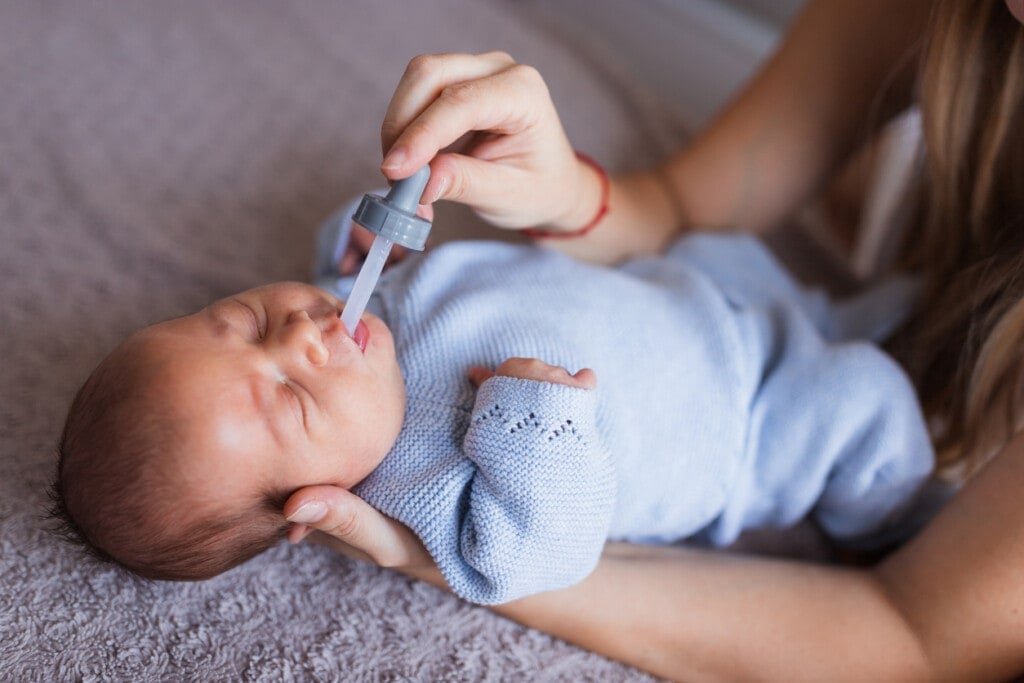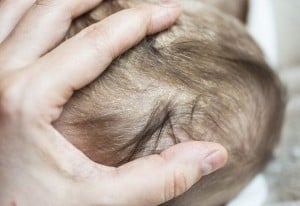It is natural to wonder what is bothering your baby when they are fussy and seem uncomfortable. Many times, infant irritability may be related to digestive discomfort.1 Many digestive functions do not fully develop until the baby is outside the womb, so it’s common for infants to experience more gastrointestinal distress in the first few weeks and months while their bellies are maturing.2 Although infants cannot tell you what is wrong, some signs of abdominal discomfort in newborns include excessive spitting up, hiccups, back arching, and irritability, particularly after eating.1
As parents, we want to relieve any pain and discomfort our newborn experiences, and we often look for products and solutions that may help our babies feel better. Many parents turn to a product called gripe water, which mothers have long touted as an at-home remedy for a fussy, uncomfortable baby.3 The U.S. Food and Drug Administration considers gripe water a dietary supplement, and they do not regulate it, so before you buy and administer it to your little one, let’s take a closer look at what it is.4
What is Gripe Water?
Gripe water was created in the 1850s by a pharmacist in the United Kingdom. It was adapted from a treatment for malaria after doctors noted that it also soothed upset babies and relieved their tummy troubles. The ingredients of gripe water have changed over the years, but the marketing and word of mouth promoting its use have always been strong.3
Today, gripe water is available as an over-the-counter supplement. It is a non-nutritive substance, containing no or very few calories and no vitamins or minerals. While there have been no United States studies on gripe water specifically, one study from India revealed it is the most common non-nutritive substance administered to infants in the first year of life.5
What is Gripe Water Used For?
Companies often market gripe water as a treatment for colic, fussiness, hiccups, gas, and other stomach discomforts in infants up to six months to a year. Most brands do not recommend their product for newborns under two weeks of age, especially breastfed infants. Until mothers establish breastfeeding habits, even small amounts of substances and supplements can impact demand and, therefore, milk supply and regulation.
What’s in Gripe Water?
Many manufacturers make and sell gripe water, so the ingredients vary slightly among brands; however, most contain some combination of the following ingredients:
- Water
- Baking soda. Also known as sodium bicarbonate, an alkaline, versatile salt substance used in cleaning, baking, and many medications.6
- Fennel. Chefs often use this potent, flowering herb in cooking and some herbal remedies.7
- Ginger. Ginger is a fragrant, zesty plant root that may help with nausea, gas, cell aging, and inflammation.8
- Dill. This is an aromatic herb like parsley used for flavoring and medicinal purposes.9
- Chamomile. Chamomile is an ancient herb traditionally used in many cultures for its medicinal properties.10
Some gripe water brands also contain sugar or a sweetener and other flavorings. Gripe water once had a significant amount of alcohol, but it is no longer part of the formula. Gripe water is free from common allergens such as milk, soy, wheat, nuts, and fish.
How Does Gripe Water Work?
Suppose an infant’s tummy discomfort is because of an overly acidic stomach. In that case, the baking soda in gripe water may help to neutralize stomach acid since the baking soda acts as a base and raises the pH of the stomach. However, medical experts agree that hyperacidity of the stomach is not typically a cause of colic or belly upset in newborns.11 The fennel in gripe water may decrease intestinal spasms and increase gut motility and was shown to reduce colic symptoms in infants in one Russian study.12
Ginger root has been proven to help encourage efficient digestion, helping food (or milk, in the case of an infant) move more quickly through the gut. This may help to resolve sensations of nausea and indigestion.13 In an Israeli study, an herbal tea concoction containing chamomile significantly reduced colic symptoms in infants.14
Since some formulations of gripe water contain sweeteners and flavoring, these components may also help to soothe a newborn. One study found that orally administered sugar water modestly reduced pain in infants undergoing medical procedures, likely due to the sweetness.15 Not many studies have investigated the effectiveness of gripe water’s exact combination of ingredients, and not every brand formulates its gripe water the same way. However, as you can see, many common elements in gripe water have been studied individually to improve digestion in infants and adults.
How to Use Gripe Water
So, you have considered your options and weighed the pros and cons. If you have decided that gripe water is something you would like to try for your baby, here is how to use it:
1. Consult with your pediatrician and make sure they are comfortable with you administering gripe water to your baby.
2. Review brands and the ingredients included and select the one you are most comfortable with. The American Academy of Family Physicians recommends avoiding versions of gripe water that contain sugar or alcohol and any from outside the United States.16
3. Read the package insert and instructions.
4. Although the gripe water dose may seem small, gripe water is best administered after breastmilk feeding or formula so your baby’s tiny tummy does not fill up on non-nutritive liquid before a feed.
5. Draw up the recommended amount into a syringe. Serving size ranges from half a teaspoon to two teaspoons depending on the age and size of your baby.
6. Do not dilute gripe water or mix it with anything, such as water or milk.
7. Wait until your baby is calm and not crying before attempting to administer gripe water.
8. Administer it in tiny drops via a syringe or dropper directed at the baby’s inner cheek, and take your time and give gripe water slowly over a few minutes. Do not point the syringe toward the tongue or back of the throat, as this may cause gagging or choking. Alternatively, you can use a bottle nipple for the baby to suck the gripe water through.
9. Refer to the package instructions, but most gripe water can be administered up to six times per day as needed.
Side Effects
A study in India examining the administration of gripe water to infants younger than six months showed no improvement in excessive crying. It showed more vomiting and constipation in those infants treated with gripe water than those who were not.17
Some manufacturers claim their product may cause a notable increase in sleepiness because babies who suffer from colic and gastrointestinal discomfort finally find relief and can relax. However, research has not backed this side effect.
Alternative Treatments
If gripe water does not sound like the right fit for you, there are other medications and interventions for similar symptoms in babies. Some of the alternatives include:
Probiotics
A systematic review of the treatments available for infantile colic suggests probiotics were the most effective at decreasing crying time, particularly in breastfed infants. The specific probiotic with the most benefit for improving colic symptoms was Lactobacillus reuteri.18
Manual Therapy
Hands-on therapies such as osteopathy, chiropractic care, and physiotherapy have shown some evidence of reduced crying and increased sleeping in infants suffering from colic.18,19
Gas Drops
Infant gas drops refer to the medication simethicone used to treat gas. It helps gas bubbles consolidate and make their way out of the body through belching and flatulence. It remains in the gastrointestinal tract and does not get absorbed into the rest of the body. Because of this, there are few side effects except mild nausea and diarrhea. But, research has not demonstrated that simethicone is an effective treatment for infant fussiness.20
Proton Pump Inhibitors
Proton pump inhibitors (PPIs), such as omeprazole, are a class of medications that work by decreasing stomach acid. Their use in treating colic and upset stomachs in infants is increasing. However, little evidence shows they are effective at reducing irritability and fussing. PPIs are associated with an increased risk of infections, allergies, and hospital admissions.18
It is important to remember that every baby gets fussy sometimes, and every baby occasionally has gas—they are young, and their bodies are still immature. For the occasional upset stomach in a newborn, gripe water probably does not have any significant side effects. Still, it is probably not the magic cure you are looking for. Be sure to talk to your pediatrician if you are concerned about your infant’s demeanor, comfort, and excessive crying. Remember that even the most colicky babies typically improve drastically by four months. Regardless of what treatment you choose, there is an end in sight!






























